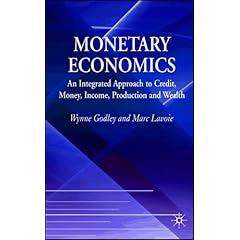关于本站
人大经济论坛-经管之家:分享大学、考研、论文、会计、留学、数据、经济学、金融学、管理学、统计学、博弈论、统计年鉴、行业分析包括等相关资源。
经管之家是国内活跃的在线教育咨询平台!
经管之家新媒体交易平台
提供"微信号、微博、抖音、快手、头条、小红书、百家号、企鹅号、UC号、一点资讯"等虚拟账号交易,真正实现买卖双方的共赢。【请点击这里访问】
期刊
- 期刊库 | 马上cssci就要更新 ...
- 期刊库 | 【独家发布】《财 ...
- 期刊库 | 【独家发布】“我 ...
- 期刊库 | 【独家发布】“我 ...
- 期刊库 | 【独家发布】国家 ...
- 期刊库 | 请问Management S ...
- 期刊库 | 英文期刊库
- 核心期刊 | 歧路彷徨:核心期 ...
TOP热门关键词
MonetaryEconomics:AnIntegratedApproachtoCredit,Money,Income,ProductionandWealthbyWynneGodley(Author),MarcLavoie(Author)Hardcover:576pagesPublisher:PalgraveMacmillan(February1,2007)Language:EnglishBook ...
扫码加入经济学习群 |
Monetary Economics: An Integrated Approach to Credit, Money, Income, Production and Wealth
by Wynne Godley (Author), Marc Lavoie (Author)

This book challenges the mainstream paradigm, which is based on the inter-temporal optimisation of welfare by individual agents, and introduces a new methodology for studying how it is institutions which create flows of income, expenditure and production together with stocks of assets (including money) and liabilities evolve through time
About the Author
WYNNE GODLEY was formerly Director of the Department of Applied Economics at the University of Cambridge, UK, from 1970 to 1994, and subsequently a Professor of Applied Economics. During this period, from 1987-1988, he was also a Visiting Professor at University of Aalborg, Denmark. Between 1994 and 2001, Professor Godley was a Distinguished Scholar at the Levy Economics Institute of Bard College, New York. Professor Godley joined CERF as a Visiting Research Associate in 2002.
MARC LAVOIE is Professor in the Department of Economics at the University of Ottawa, Canada. He has been Visiting Professor at Curtin University, Australia, and at the universities of Bordeaux, Grenoble, Lille, Limoges, Nice, Rennes, Paris-1 and Paris-13. His main research areas are in post-Keynesian and monetary economics. He has written over 130 journal articles or book chapters as well as authoring Foundations of Post-Keynesian Economics and co-edited Central Banking in the Modern World. Contents
Notations Used in the Book ix
List of Tables xviii
List of Figures xx
Preface xxxiv
1 Introduction 1
1.1 Two paradigms 1
1.2 Aspiration 4
1.3 Endeavour 9
1.4 Provenance 11
1.5 Some links with the ‘old’ Yale school 13
1.6 Links with the post-Keynesian school 16
1.7 A sketch of the book 18
A1.1 Compelling empirical failings of the neo-classical
production function 20
A1.2 Stock-flow relations and the post-Keynesians 21
2 Balance Sheets, Transaction Matrices and the Monetary Circuit 23
2.1 Coherent stock-flow accounting 23
2.2 Balance sheets or stock matrices 25
2.3 The conventional income and expenditure matrix 33
2.4 The transactions flow matrix 37
2.5 Full integration of the balance sheet and the transactions
flow matrices 43
2.6 Applications of the transactions flow matrix: the monetary
circuit 47
3 The Simplest Model with Government Money 57
3.1 Government money versus private money 57
3.2 The service economy with government money and no
portfolio choice 58
3.3 Formalizing Model SIM 61
3.4 A numerical example and the standard Keynesian multiplier 68
3.5 Steady-state solutions 71
3.6 The consumption function as a stock-flow norm 74
3.7 Expectations mistakes in a simple stock-flow model 78
3.8 Out of the steady state 83
3.9 A graphical illustration of Model SIM 88
3.10 Preliminary conclusion 91
A3.1 Equation list of Model SIM 91
A3.2 Equation list of Model SIM with expectations (SIMEX) 92
A3.3 The mean lag theorem 92
A3.4 Government deficits in a growing economy 95
4 Government Money with Portfolio Choice 99
4.1 Introduction 99
4.2 The matrices of Model PC 99
4.3 The equations of Model PC 102
4.4 Expectations in Model PC 107
4.5 The steady-state solutions of the model 111
4.6 Implications of changes in parameter values on temporary
and steady-state income 116
4.7 A government target for the debt to income ratio 124
A4.1 Equation list of Model PC 126
A4.2 Equation list of Model PC with expectations (PCEX) 126
A4.3 Endogenous money 127
A4.4 Alternative mainstream closures 129
5 Long-term Bonds, Capital Gains and Liquidity Preference 131
5.1 New features of Model LP 131
5.2 The value of a perpetuity 131
5.3 The expected rate of return on long-term bonds 132
5.4 Assessing capital gains algebraically and geometrically 134
5.5 Matrices with long-term bonds 136
5.6 Equations of Model LP 137
5.7 The short-run and long-run impact of higher interest rates
on real demand 150
5.8 The effect of household liquidity preference on long rates 153
5.9 Making government expenditures endogenous 160
A5.1 Equations of Model LP 165
A5.2 The liquidity trap 167
A5.3 An alternative, more orthodox, depiction of the bond market 168
6 Introducing the Open Economy 170
6.1 A coherent framework 170
6.2 The matrices of a two-region economy 171
6.3 The equations of a two-region economy 173
6.4 The steady-state solutions of Model REG 176
6.5 Experiments with Model REG 180
6.6 The matrices of a two-country economy 187
6.7 The equations of a two-country economy 191
6.8 Rejecting the Mundell–Fleming approach and adopting
the compensation approach 194
Contents vii
6.9 Adjustment mechanisms 201
6.10 Concluding thoughts 207
A6.1 Equations of Model REG 209
A6.2 Equations of Model OPEN 211
A6.3 Historical and empirical evidence concerning the
compensation principle 213
A6.4 Other institutional frameworks: the currency board 214
A6.5 How to easily build an open model 215
7 A Simple Model with Private Bank Money 217
7.1 Private money and bank loans 217
7.2 The matrices of the simplest model with private money 218
7.3 The equations of Model BMW 222
7.4 The steady state 227
7.5 Out-of-equilibrium values and stability analysis 233
7.6 The role of the rate of interest 240
7.7 A look forward 247
A7.1 The equations of Model BMW 247
8 Time, Inventories, Profits and Pricing 250
8.1 The role of time 250
8.2 The measure of profits 252
8.3 Pricing 263
8.4 Numerical examples of fluctuating inventories 276
A8.1 A Numerical example of inventory accounting 278
9 A Model with Private Bank Money, Inventories and Inflation 284
9.1 Introduction 284
9.2 The equations of Model DIS 285
9.3 Additional properties of the model 293
9.4 Steady-state values of Model DIS 295
9.5 Dealing with inflation in (a slightly modified) Model DIS 300
A9.1 Equation list of Model DIS 308
A9.2 The peculiar role of given expectations 310
A9.3 Equation list of Model DISINF 312
10 A Model with both Inside and Outside Money 314
10.1 A model with active commercial banks 314
10.2 Balance sheet and transaction matrices 315
10.3 Producing firms 318
10.4 Households 322
10.5 The government sector and the central bank 331
10.6 The commercial banking system 333
10.7 Making it all sing with simulations 342
10.8 Conclusion 374
A10.1 Overdraft banking systems 374
A10.2 Arithmetical example of a change in portfolio preference 376
11 A Growth Model Prototype 378
11.1 Prolegomena 378
11.2 Balance sheet, revaluation and transactions-flow matrices 379
11.3 Decisions taken by firms 383
11.4 Decisions taken by households 392
11.5 The public sector 397
11.6 The banking sector 399
11.7 Fiscal and monetary policies 404
11.8 Households in the model as a whole 422
11.9 Financial decisions in the model as a whole 435
11.10 A concluding recap 441
12 A More Advanced Open Economy Model 445
12.1 Introduction 445
12.2 The two matrices 446
12.3 Equations of the generic model 450
12.4 Alternative closures 462
12.5 Experiments with the main fixed exchange rate closure 466
12.6 Experiments with alternative fixed exchange rate closures 472
12.7 Experiments with the flexible exchange rate closure 478
12.8 Lessons to be drawn 487
A12.1 A fundamental and useful open-economy flow-of-funds
identity 490
A12.2 An alternative flexible exchange rate closure 492
13 General Conclusion 493
13.1 Unique features of the models presented here 493
13.2 A summary 499
References 501
Index 514
「经管之家」APP:经管人学习、答疑、交友,就上经管之家!
免流量费下载资料----在经管之家app可以下载论坛上的所有资源,并且不额外收取下载高峰期的论坛币。
涵盖所有经管领域的优秀内容----覆盖经济、管理、金融投资、计量统计、数据分析、国贸、财会等专业的学习宝库,各类资料应有尽有。
来自五湖四海的经管达人----已经有上千万的经管人来到这里,你可以找到任何学科方向、有共同话题的朋友。
经管之家(原人大经济论坛),跨越高校的围墙,带你走进经管知识的新世界。
扫描下方二维码下载并注册APP

免流量费下载资料----在经管之家app可以下载论坛上的所有资源,并且不额外收取下载高峰期的论坛币。
涵盖所有经管领域的优秀内容----覆盖经济、管理、金融投资、计量统计、数据分析、国贸、财会等专业的学习宝库,各类资料应有尽有。
来自五湖四海的经管达人----已经有上千万的经管人来到这里,你可以找到任何学科方向、有共同话题的朋友。
经管之家(原人大经济论坛),跨越高校的围墙,带你走进经管知识的新世界。
扫描下方二维码下载并注册APP

您可能感兴趣的文章
本站推荐的文章
人气文章
本文标题:[下载]07《货币经济学》(Monetary Economics)
本文链接网址:https://bbs.pinggu.org/jg/kaoyankaobo_kaoyan_296398_1.html
2.转载的文章仅代表原创作者观点,与本站无关。其原创性以及文中陈述文字和内容未经本站证实,本站对该文以及其中全部或者部分内容、文字的真实性、完整性、及时性,不作出任何保证或承若;
3.如本站转载稿涉及版权等问题,请作者及时联系本站,我们会及时处理。



